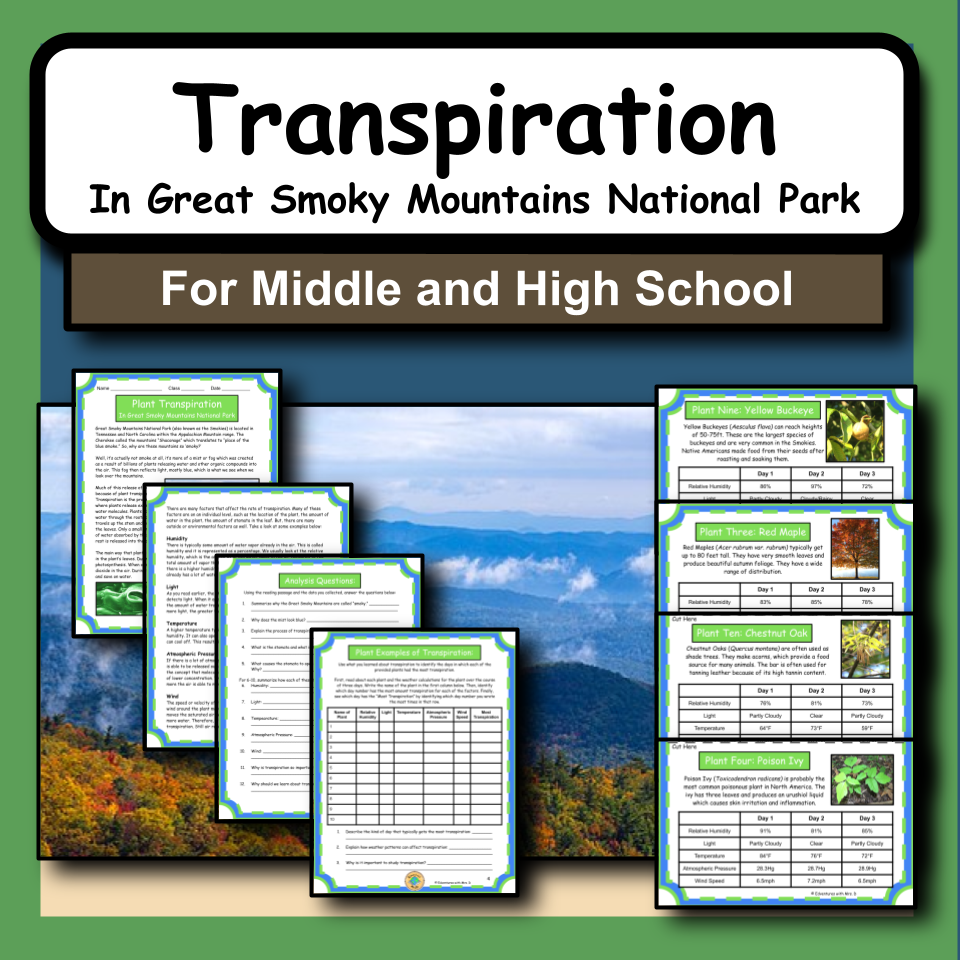
Transpiration in Great Smoky Mountains National Park
For Middle and High School
$3.50$3.00
Dive into the wonders of nature with our comprehensive educational packet, 'Transpiration in Great Smoky Mountains National Park.' Tailored for middle and high school students, this packet includes a wealth of informative pages and engaging activities focused on understanding plant transpiration. Whether you're a teacher looking to enrich your curriculum or a student eager to explore botanical processes, this packet, designed to captivate and educate, is an invaluable resource. Enhance learning with vivid examples and compelling facts about one of America's most iconic national parks. Ideal for science classes, homeschool and nature enthusiasts.
Transpiration is the process where plants release water vapor into the air. This is an important part of the water cycle and there are many factors that affect the amount of transpiration that happens in a certain area. Great Smoky Mountains National Park, for example, has a high rate of transpiration, which is why we often see that blue mist across the area (which is how the Smokies got their name).
Students will learn all this and more in this activity. They will also focus on five major factors that affect transpiration: Relative Humidity, Light, Temperature, Atmospheric Pressure and Wind.
First, the students will read a two-page passage about transpiration, Great Smoky Mountains, Stomata, and about the five major factors. They will then answer 12 questions about what they just read. For example, they will be asked "what is the stomata and what is their purpose?" "Summarize why the Great Smoky Mountains are called 'smoky.'" and "Summarize how each of the factors affect transpiration in plants."
Then, students will go around the room and read about 10 different plants that are found in Great Smoky Mountains National Park. As they read, they will also see a data table, for each plant, which has the weather patterns written out for three different days. Students will use what they learned in the reading earlier to analyze the data tables and decide which day has the most transpiration for each plant. For example, it may say that the relative humidity was 85% on Day 1, 96% on Day 2 and 82% on Day 3. They read that the lower the humidity, the more transpiration occurs. So, they will write that Day 3 had the most transpiration. They will do this for all five factors (humidity, light, temperature, atmospheric pressure and wind speed) for all ten plants.
Finally, students will answer three final analysis questions.
This activity can be done individually, in small groups, or as a whole class, depending on how you want to conduct the activity.
This product includes:
Teacher Directions-including prep info and materials needed
Teacher Procedure
Student Packet-2 page reading, 12 questions, data table and 3 analysis questions
Student Packet Answers
Data Table Answers
Teacher Tips
Websites and Citations
5 Pages of Plant Examples (2 on each page)
To do this activity, you will need:
Pencil
Copy of "Plant Transpiration" packet for each student (INCLUDED)
Copy of Plant Example Pages (INCLUDED)
Optional: tape or magnets to hang the plant examples around the room in 'stations.'
Scissors (to cut out example pages), or you can fold the paper and rip apart.
Check out my Youtube Channel for FREE informational videos about the national parks along with FREE video guides for your students!
Join my email list here to learn about ways to encourage students to experience the content!
You can also follow me on Pinterest, Instagram, Facebook and YouTube!
If you have any questions, feel free to email me at edventureswithmrsd@gmail.com.
Thank you!
6th-12th
Science
General Science
National Parks
Earth Science
Plant Biology
16 Pages
"Excellent resource. Students practiced skills of data collection, inference and learned about many native plant species to their home state in the process. A multi-discipline learning experience, thank you!" Deborah M.
"This was a wonderful way of showing how important the plants are in continuing the water cycle. We used a different part of the United States to then apply the idea of transpiration to where we live. It allowed students to understand how this applies world wide as a huge part of keeping the water cycle going on Earth. They enjoyed using the resource." Lisa C.
